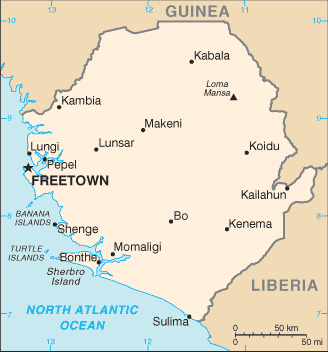|
Sierra Leone
|

|
Capital: Freetown
Population: 7,813,215
Brief History of Sierra Leone:
Sierra Leon has been inhabited by tribal peoples for thousands of years. The name comes from the Portugeuse for Lions Mountains, Serra de Leao. The first European to explore Sierra Leon was Pedro da Cintra from Portugal. He mapped out the hills surrounding what is today Freetown Harbour.
In the early 1900s, Freetown was home to the British governor of the Gold Coast. In 1961, Sierra Leon became a fully independent country. From 1991 to 2002 Sierra Leon was ravaged by civil war. Thousands were killed during the war and millions more were displaced. Today the country is still trying to recover.
The Geography of Sierra Leone
Total Size: 71,740 square km
Size Comparison: slightly smaller than South Carolina
Geographical Coordinates: 8 30 N, 11 30 W
World Region or Continent: Africa
General Terrain: coastal belt of mangrove swamps, wooded hill country, upland plateau, mountains in east
Geographical Low Point: Atlantic Ocean 0 m
Geographical High Point: Loma Mansa (Bintimani) 1,948 m
Climate: tropical; hot, humid; summer rainy season (May to December); winter dry season (December to April)
Major cities: FREETOWN (capital) 875,000 (2009)
The People of Sierra Leone
Type of Government: constitutional democracy
Languages Spoken: English (official, regular use limited to literate minority), Mende (principal vernacular in the south), Temne (principal vernacular in the north), Krio (English-based Creole, spoken by the descendants of freed Jamaican slaves who were settled in the Freetown area, a lingua franca and a first language for 10% of the population but understood by 95%)
Independence: 27 April 1961 (from UK)
National Holiday: Independence Day, 27 April (1961)
Nationality: Sierra Leonean(s)
Religions: Muslim 60%, indigenous beliefs 30%, Christian 10%
National Symbol: lion
National Anthem or Song: High We Exalt Thee, Realm of the Free
Economy of Sierra Leone
Major Industries: diamond mining; small-scale manufacturing (beverages, textiles, cigarettes, footwear); petroleum refining, small commercial ship repair
Agricultural Products: rice, coffee, cocoa, palm kernels, palm oil, peanuts; poultry, cattle, sheep, pigs; fish
Natural Resources: diamonds, titanium ore, bauxite, iron ore, gold, chromite
Major Exports: diamonds, rutile, cocoa, coffee, fish
Major Imports: foodstuffs, machinery and equipment, fuels and lubricants, chemicals
Currency: leone (SLL)
National GDP: $6,795,000,000
** Source for population (2012 est.) and GDP (2011 est.) is CIA World Factbook.
Back to Geography Home Page
